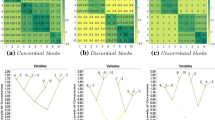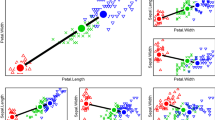Abstract
Parsimonious Gaussian mixture models are developed using a latent Gaussian model which is closely related to the factor analysis model. These models provide a unified modeling framework which includes the mixtures of probabilistic principal component analyzers and mixtures of factor of analyzers models as special cases.
In particular, a class of eight parsimonious Gaussian mixture models which are based on the mixtures of factor analyzers model are introduced and the maximum likelihood estimates for the parameters in these models are found using an AECM algorithm. The class of models includes parsimonious models that have not previously been developed.
These models are applied to the analysis of chemical and physical properties of Italian wines and the chemical properties of coffee; the models are shown to give excellent clustering performance.
Similar content being viewed by others
References
Banfield, J.D., Raftery, A.E.: Model-based Gaussian and non-Gaussian clustering. Biometrics 49(3), 803–821 (1993)
Bartholomew, D.J., Knott, M.: Latent Variable Models and Factor Analysis, 2nd edn. Edward Arnold, London (1999)
Biernacki, C., Celeux, G., Govaert, G.: Assessing a mixture model for clustering with the integrated completed likelihood. IEEE Trans. Pattern Anal. Mach. Intell. 22(7), 719–725 (2000)
Böhning, D., Dietz, E., Schaub, R., Schlattmann, P., Lindsay, B.: The distribution of the likelihood ratio for mixtures of densities from the one-parameter exponential family. Ann. Inst. Stat. Math. 46, 373–388 (1994)
Celeux, G., Govaert, G.: Gaussian parsimonious clustering models. Pattern Recogn. 28, 781–793 (1995)
Chang, W.-C.: On using principal components before separating a mixture of two multivariate normal distributions. J. Roy. Stat. Soc. Ser. C 32(3), 267–275 (1983)
Dean, N., Raftery, A.E.: The clustvarsel package. R package version 0.2-4 (2006)
Dempster, A.P., Laird, N.M., Rubin, D.B.: Maximum likelihood from incomplete data via the EM algorithm. J. Roy. Stat. Soc. Ser. B 39(1), 1–38 (1977) (with discussion)
Forina, M., Armanino, C., Castino, M., Ubigli, M.: Multivariate data analysis as a discriminating method of the origin of wines. Vitis 25, 189–201 (1986)
Fraley, C., Raftery, A.E.: How many clusters? Which clustering method? Answers via model-based cluster analysis. Comput. J. 41(8), 578–588 (1998)
Fraley, C., Raftery, A.E.: Mclust: Software for model-based clustering. J. Classif. 16, 297–306 (1999)
Fraley, C., Raftery, A.E.: Model-based clustering, discriminant analysis, and density estimation. J. Am. Stat. Assoc. 97(458), 611–612 (2002)
Fraley, C., Raftery, A.E.: Enhanced model-based clustering, density estimation and discriminant analysis software: MCLUST. J. Classif. 20(2), 263–296 (2003)
Ghahramani, Z., Hinton, G.E.: The EM algorithm for factor analyzers. Technical report CRG-TR-96-1, University of Toronto, Toronto (1997)
Hubert, L., Arabie, P.: Comparing partitions. J. Classif. 2, 193–218 (1985)
Hurley, C.: Clustering visualizations of multivariate data. J. Comput. Graph. Stat. 13(4), 788–806 (2004)
Kass, R.E., Raftery, A.E.: Bayes factors. J. Am. Stat. Assoc. 90, 773–795 (1995)
Keribin, C.: Estimation consistante de l’ordre de modèles de mélange. C. R. Acad. Sci. Paris Sér. I Math. 326(2), 243–248 (1998)
Keribin, C.: Consistent estimation of the order of mixture models. Sankhyā Ser. A 62(1), 49–66 (2000)
Lindsay, B.: Mixture Models: Theory, Geometry and Applications. Institute of Mathematical Statistics, Hayward (1995)
Lütkepohl, H.: Handbook of Matrices. Wiley, Chichester (1996)
McLachlan, G.J., Basford, K.E.: Mixture Models: Inference and Applications to Clustering. Marcel Dekker, New York (1988)
McLachlan, G.J., Krishnan, T.: The EM Algorithm and Extensions. Wiley, New York (1997)
McLachlan, G.J., Peel, D.: Finite Mixture Models. Wiley, New York (2000)
McLachlan, G.J., Peel, D., Bean, R.W.: Modelling high-dimensional data by mixtures of factor analyzers. Comput. Stat. Data Anal. 41(3–4), 379–388 (2003)
Meng, X.L., van Dyk, D.: The EM algorithm—an old folk song sung to the fast tune (with discussion). J. Roy. Stat. Soc. Ser. B 59, 511–567 (1997)
Press, W.H., Teukolsky, S.A., Vetterling, W.T., Flannery, B.P.: Numerical Recipies in C—The Art of Scientific Computation, 2nd edn. Cambridge University Press, Cambridge (1992)
R Development Core Team: R: A Language and Environment for Statistical Computing. R Foundation for Statistical Computing, Vienna (2004)
Rand, W.M.: Objective criteria for the evaluation of clustering methods. J. Am. Stat. Assoc. 66, 846–850 (1971)
Schwartz, G.: Estimating the dimension of a model. Ann. Stat. 6, 31–38 (1978)
Spearman, C.: The proof and measurement of association between two things. Am. J. Psychol. 15, 72–101 (1904)
Streuli, H.: Der heutige stand der kaffeechemie. In: 6th International Colloquium on Coffee Chemisrty. Association Scientifique International du Cafe, Bogatá, Columbia, pp. 61–72 (1973)
Tipping, M.E., Bishop, C.M.: Mixtures of probabilistic principal component analysers. Neural Comput. 11(2), 443–482 (1999a)
Tipping, M.E., Bishop, C.M.: Probabilistic principal component analysis. J. Roy. Stat. Soc. Ser. B 61(3), 611–622 (1999b)
Titterington, D.M., Smith, A.F.M., Makov, U.E.: Statistical Analysis of Finite Mixture Distributions. Wiley, Chichester (1985)
Author information
Authors and Affiliations
Corresponding author
Rights and permissions
About this article
Cite this article
McNicholas, P.D., Murphy, T.B. Parsimonious Gaussian mixture models. Stat Comput 18, 285–296 (2008). https://doi.org/10.1007/s11222-008-9056-0
Received:
Accepted:
Published:
Issue Date:
DOI: https://doi.org/10.1007/s11222-008-9056-0




